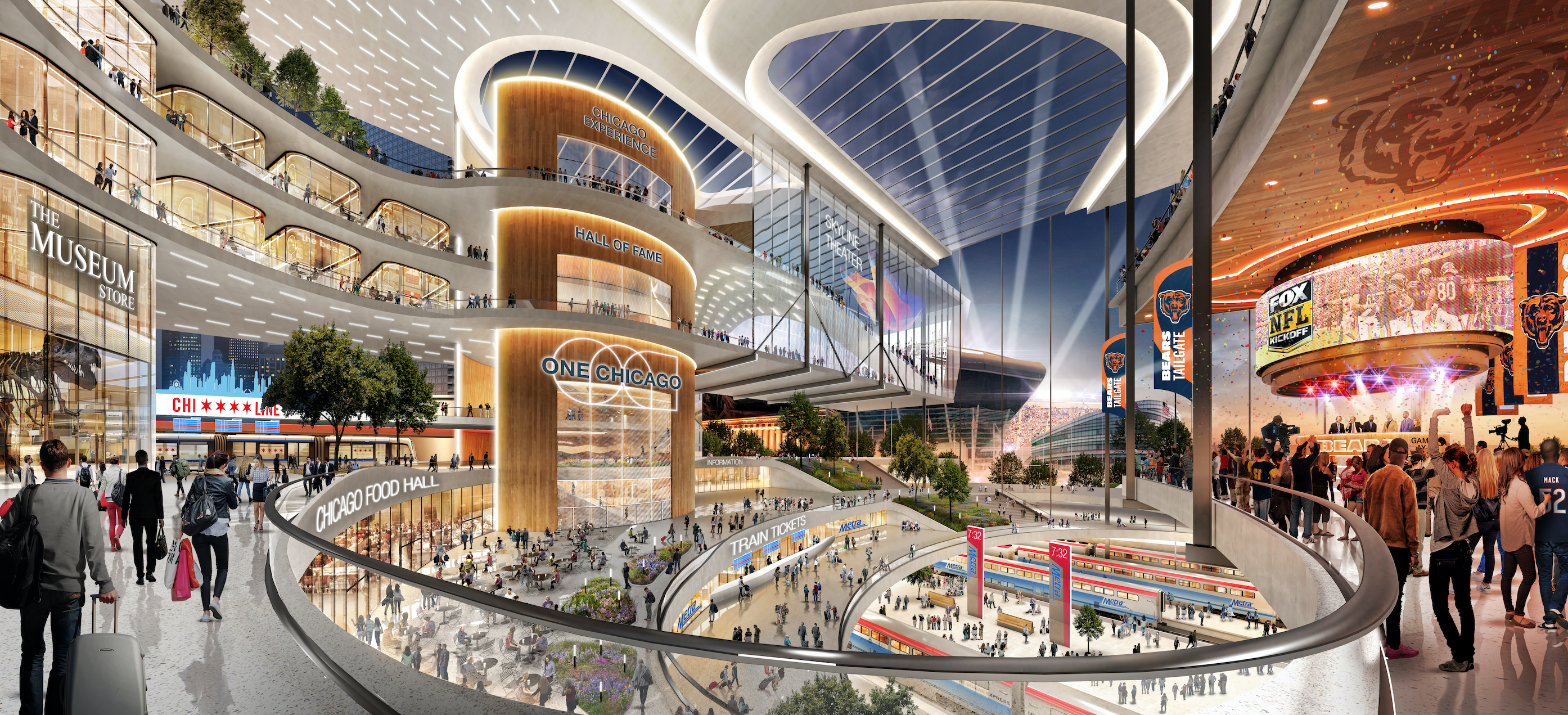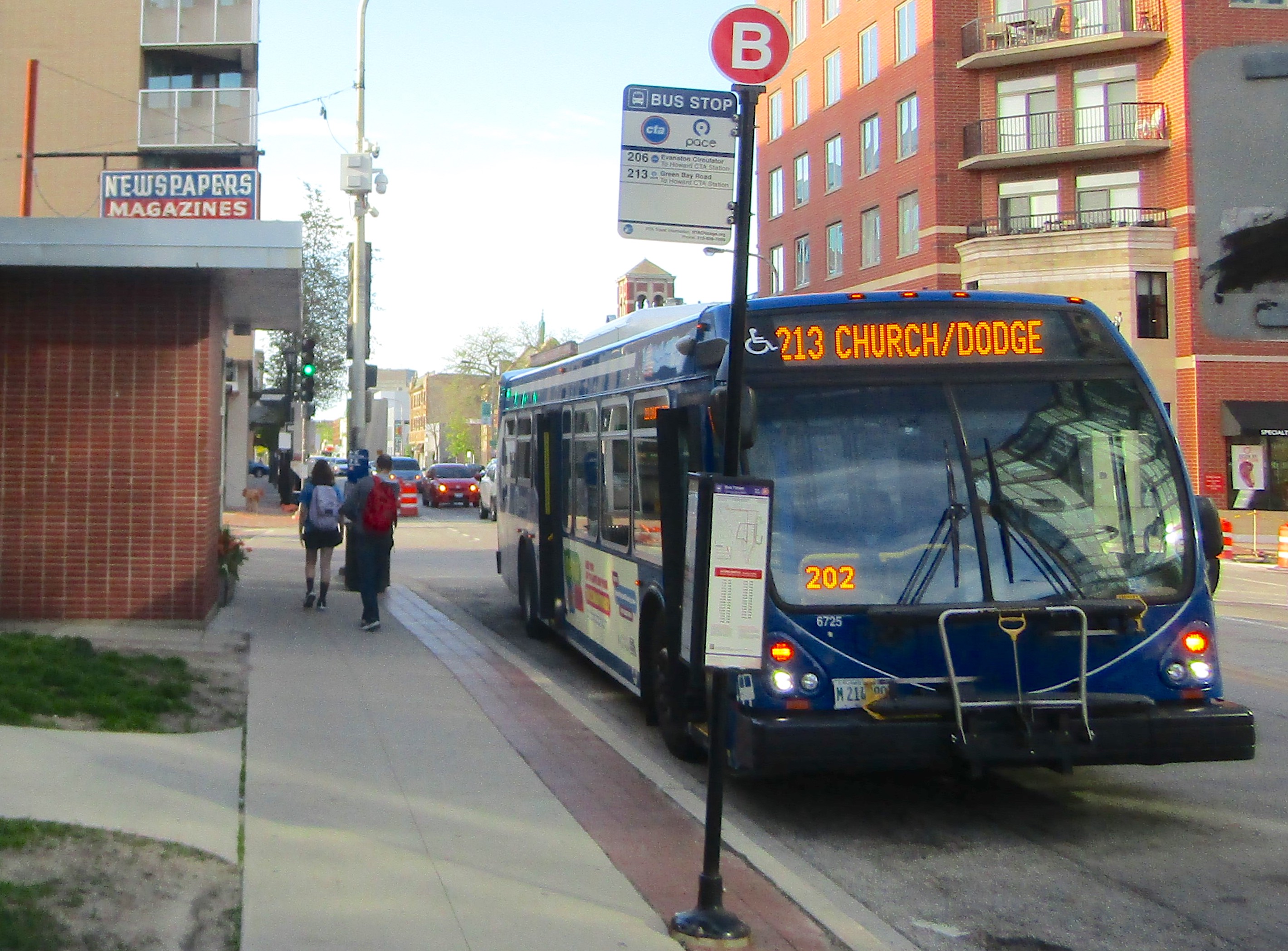The One Central Development Looks to Transform the South Loop, But at What Cost?
1:30 PM CDT on May 16, 2019

Rendering of the proposed One Central atrium. Image: Perkins + Will/Landmark Development
Move over Lincoln Yards and The 78, a new mega-development has cannonballed into Chicago’s increasingly crowded pool of massive mixed-use projects that are poised to reshape entire sections of the city. This latest plan, dubbed One Central, comes from Wisconsin-based Landmark Development, which is proposing a series of soaring skyscrapers and a major new transportation hub over open-air rail tracks between Soldier Field and McCormick Place. The project could cost upwards of $20 billion and take 15 years to complete, being one of the priciest and most ambitious developments in Chicago, ever.
The number of apartments units, hotel rooms, and amount of office space is still yet to be determined, but the developer is putting a big emphasis on its plan to connect Chicago’s various forms of mass transit with its “Chi-line” Museum Campus circulator and central transportation hub that would link the CTA’s Orange Line, Amtrak, and BNSF rail. And with Lake Shore Drive and the Chicago Lakefront Trail just steps away, the mega-development is shaping up to have the best transportation plan of the crowded field of mega-developments yet—an issue that had been a point of contention during the Lincoln Yards public input process.
Another important piece of this big deal was when Landmark reps announced that they would not seek inclusion in a tax-increment financing district back in March when the proposal was first revealed. Under Mayor Emanuel’s administration, the use of TIF districts, which freeze property tax rates for 23 years (here’s a great explainer from policy experts Daniel Kay Hertz and Amanda Kass) and reimburses developers with future property tax gains from the district, has been viewed as a gravy train for clout-rich developers by critics of the funding tool.
Due to the controversy over the Lincoln Yards and The 78 TIF districts, which combined are approved to receive up to $2.4 billion in reimbursements over the next couple of decades, the idea of using TIF for future major developments has become all but toxic. In the last year, there has been much public scrutiny and outcry over the idea of rewarding wealthy developers with much needed tax revenues that would otherwise benefit city services, most notably public schools.
Landmark appears to have been paying close attention to the debates surrounding Lincoln Yards, The 78, and the use of TIF districts, and decided early on not to drag Chicago’s weary taxpayers through yet another TIF battle. Instead, Landmark Development has come up with a new financing model—one which leans on the state of Illinois instead of the city of Chicago.
But remember that classic episode of "Seinfeld" when Jerry suggests “hiding the crazy” for at least the first few months of courting a potential partner? It seems like solid advice that Landmark Development should have considered before unveiling the latest rendering and financing scheme for its One Central plan.
Instead of seeking TIF dollars, Landmark is asking the state of Illinois for help in financing the construction of One Central’s transportation center to the tune of $3.8 billion worth of assistance. In return, the state of Illinois would eventually take ownership over the transit and retail hub, says Landmark Development president Bob Dunn.
The reimbursement amount is mind-boggling, especially so when considering the state’s precarious financial standing and the fact that Governor J.B. Pritzker is actively trying to sell the Loop’s Thompson Center—a vitally important, existing transit hub—to fill a hole in the state’s budget. And with the state of Illinois being engaged for financial assistance, it’s unclear how much say will the public will ultimately have in the funding scheme for the One Central transportation center.
Additionally, Landmark Development’s newly unveiled conceptual rendering for the One Central transit hub and retail complex is a feast for the eyes, depicting tourist-friendly attractions such as a Bears-themed experience, a theater, and even a Field Museum gift shop in a multi-level indoor-outdoor structure. The image caused a buzz across social media, with many comparing the project to malls like the Loop’s Block Thirty Seven or Lincoln Park’s Century Shopping Centre. One Twitter user suggested that the rendered concept looked like something "Office Space" and "Idiocracy" director Mike Judge would come up with if he was trying to poke fun at Midwest stereotypes—Chicago Bears bar and all.
But Dunn says that the proposed development and eventual sale of the transportation hub and commercial complex would ultimately be a benefit to state coffers. “In a TIF district, public dollars flow into a project and they stay in that project with the private sector owning that asset and the appreciating value,” Dunn says. “But in this sense [of the One Central financing model], the state takes ownership of the asset and the appreciating value of the asset.”
Dunn says there are two main buckets that the infrastructure improvements for these mega-projects fall under: civic infrastructure and civil infrastructure. According to Dunn, civil infrastructure is the basic site improvements—roads, utilities, etc—necessary to make a project feasible, while civic infrastructure are improvements “to achieve significant growth of tax base.” One Central represents Dunn’s vision of civic infrastructure, which would have a widespread effect on transit connectivity and job creation outside of the boundaries of the project’s property line.
It’s the kind of talk that Rahm and his planning department likes to hear—the theme of developing with the intent of increasing the property tax base for our fiscally fragile city. Dunn also hits on tourism, another key theme of Mayor Emanuel’s legacy, saying that the transit hub and retail offerings at One Central would be a boon for the entire city, not just the South Loop.
While 3rd Ward alderman Pat Dowell concedes that the plan is highly complex and challenging, she says that there will be a robust community input process in the coming weeks for South Loop residents to learn more about the proposal. The caveat, Dowell notes, is that there’s already been a longstanding proposal in place for the site — Planned Development 499, also known as Central Station—and that residents have to understand that there’s already been approvals to build at the site.
But it’s the amount of increased density, impact on schools, and public safety that Alderman Dowell says she needs to receive more fleshed-out answers on before approving any changes.
“I’d say the plan as proposed by Landmark is in its infancy and requires a thorough review, not just by my office, but by my constituents and various city departments that will have to weigh in,” Alderman Dowell says. “I’ve asked the developer to go through a series of workshops because there are some people who love it and want these nice tall buildings because it adds vitality to the South Loop and adds extra revenue to the city, and then there are people who have the perspective that the buildings are too high and have concerns about view corridors.”
But with a well-publicized and highly controversial series of public meetings for Lincoln Yards and the 78, Dowell says that there will be multiple workshops and informational sessions towards the end of May and early June. The goal, Dowell says, will be to find a compromise.
“What I’m trying to do is find a win-win for the city, my community, constituents, and the developer,” Dowell says. “It’s a difficult project and not one that I intend to rush though.”
The times, dates, and location for the workshops are still TBD, but with the battles over Lincoln Yard and 78 still in recent memory, a robust community input process for One Central is more vital than ever.
Stay in touch
Sign up for our free newsletter
More from Streetsblog Chicago
Elevated Chicago’s new leader on how to build more support for equitable transit-oriented development
Recently announced as executive director Juan Sebastian Arias also shared his POV on Mayor Johnson's Cut the Tape initiative to speed up the development approval process
Since COVID, Pace ridership has fared better on major corridors and in north, northwest suburbs than in south, west ‘burbs
The suburban bus system's top five busiest routes largely maintained their ridership rankings.



